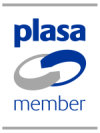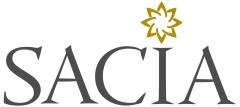02 June 2010
Story courtesy Louise Stickland
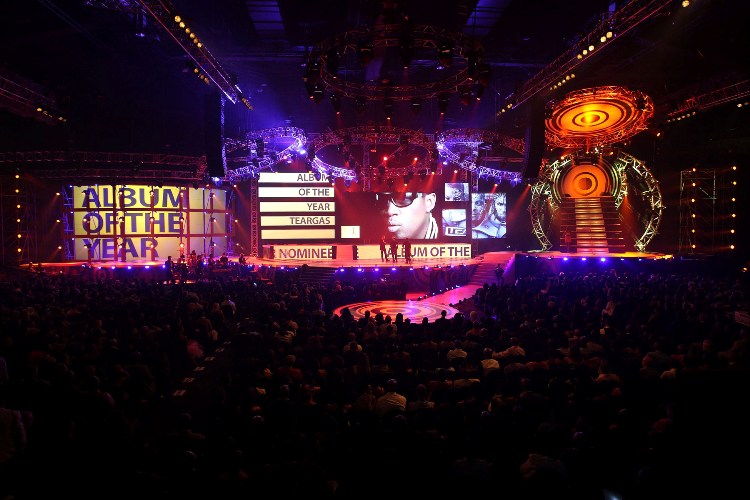 Gearhouse SA were in the “Best” SAMA Production to date. That was the general consensus of opinion apparent to anyone watching the 2010 MTN SAMAs webcast, as countless winners and artists voiced their opinions on the awesome looking stage and set during their post performance interviews at Sun City Superbowl, South Africa, for the country’s premier music awards.
Gearhouse SA were in the “Best” SAMA Production to date. That was the general consensus of opinion apparent to anyone watching the 2010 MTN SAMAs webcast, as countless winners and artists voiced their opinions on the awesome looking stage and set during their post performance interviews at Sun City Superbowl, South Africa, for the country’s premier music awards.
The event’s lighting, set and visuals were designed by Tim Dunn and the spectacular end product of a truly collaborative effort between show producers, Vertical Limit Productions, Gearhouse SA, The Recording Industry of South Africa (RiSA), Elmir Arnautovic of The Project and the SAMAs Executive Creative Director, Andrew Wessels.
The team took the style, presentation and aesthetics up a few notches from previous years, setting a new benchmark and delivering an extravaganza fitting to the stature and profile of the occasion, which included 13 live performances plus numerous Awards.
All technical production elements were supplied by Gearhouse South Africa. It was broadcast live by SABC1, and the event was project managed for Gearhouse by Bonni Meyer.
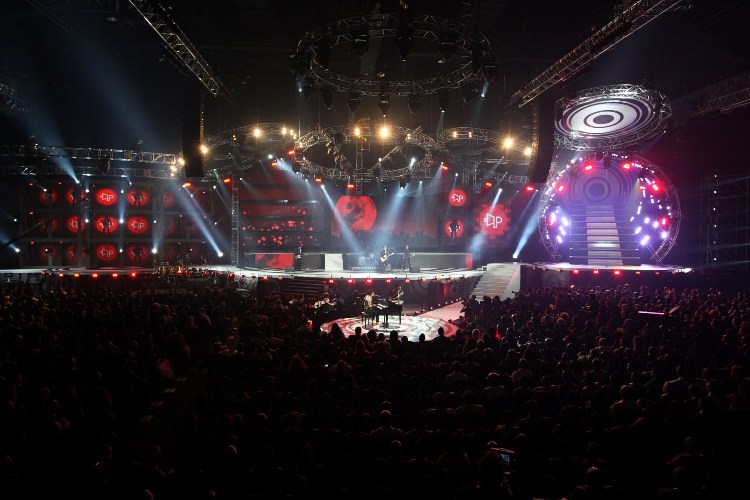 Design
Design
The mission was to WOW the audience – both on TV and those watching live – and ensure it was the most dynamic and visually exciting SAMAs to date!
The 46 metre wide by 27 metre deep set featured multiple performance areas. “It is a music show,” says Dunn, “And we wanted to make sure it looked and felt that way, with lots of drama, emotion and variations”. The different stages worked individually for certain sections of the show, and together as one super-sized space for others.
The design skilfully integrated the key visual layers of lighting, screens and scenic elements into a seamlessly elegant space, providing plenty of camera-candy and expectation for the TV and a constantly shifting environment for the live audience.
Dunn also wanted to keep it simple and uncluttered, emphasising shape, form and colours rather than lots of blingey, distracting LED surfaces. The key elements were to light the artists, communicate the information, create a buzz and stamp a clear visual identity on the 16th SAMA Awards.
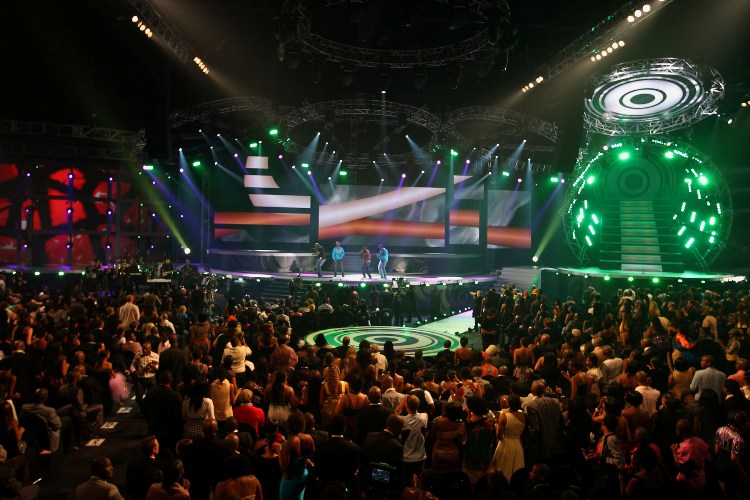 Lighting
Lighting
The lighting rig used over 160 moving lights – a mix of Robe and Martin Professional units, along with nearly 200 LED fixtures – Robe REDWash 3●192s and i-Pix Satellites and BB4s.
He chose these LED sources for the depth and 3-dimensionality they brought to the set illuminations, along with their rich colouration.
The 52 BB4s were positioned around the inside of the circular trussing framework that encased an impressive set of sweeping stairs on stage left. The round trusses decreased in size perspective front to back, giving it a tunnel like appearance.
Each cell of the BB4 units was individually patched, allowing the creation of some weird, wonderful and bizarre chases and aberrations of light as the individual pixels whizzed around.
The Satellites were attached to the front fascias of the different stages about a metre apart, which looked fabulous on camera, and the REDWashes were used to wash the stages in deep saturated colours for the live acts.
Dunn operated all the lighting – which also included conventional lighting and two 2K Xenon searchlights as well as two 5K Xenon searchlights positioned each side of stage and used for powerful cross stage swipes – from a grandMA full size console, with another for “hot” backup.
Stage Build
Gearhouse’s sister company Sets, Drapes and Screens (SDS) built the set, which included an 18 metre revolve in the centre, specially engineered by In2Structures, another Gearhouse company. The revolve was used for swapping between band backlines and for getting different pieces of scenery onstage for the upcoming performances, helping provide a lively and constantly changing environment and making the camera shots that much more interesting.
On the stage left, the entrance steps were elevated 8 metres high at the back, complete with an opening door made from a painted skin to match the set.
The load in time was tight – 3 days to put in a massive amount of set – but Dunn’s design also accounted for this, enabling the SDS team to work efficiently.
They did so initially in round-the-clock shifts of 10 people, and built a scaffolding superstructure across the entire space. Once this was completed the various set elements were installed in strict order, first a large ground support system to hang the upstage LED screens, then the revolve, and then the circular stages. Having the scaffolding in place speeded up the rest of the process significantly.
The larger circular stages were 9.3 and 8.1 metres in diameter respectively and the presenter stage was 4.6 metres and positioned out in the audience, joined to the main stage by a thrust. There were also 2 x 8 metre circular stages built from scaffolding on one side of the revolve – just to keep that air of unpredictability. The ‘skirt’ of the revolve was inset with LED panels helping make up a complete jigsaw of LED across the stage.
The facility to pre-cut the set pieces on SDS’s CNC machines back in Johannesburg also made everything much faster.
Once all the staging components were in place, all 1240 square metres of the set was painted in situ, as per the design.
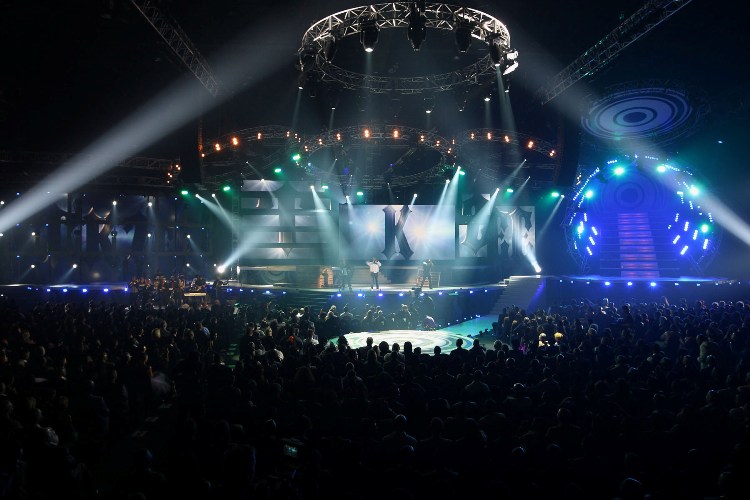 Media & AV
Media & AV
All audio visual content was provided by The Project with creative direction by Elmir Arnautovic who worked closely with the Gearhouse Media and Lighting teams to integrate all the show’s AV aspects.
As is usually the case on high profile events like this, Dunn worked closely with his regular FOH visuals team, pixel crunchers Marcel Wijnberger and Chris Grandin of Gearhouse Media, and lighting director Hugh Turner, who assisted in cracking jokes and programming the show with Dunn in addition to calling follow spots. The screen design worked in perfect harmony with the rest of the shapes and contours of the set, the sweeping staircase on stage left and the multi-layers of round stages.
On far stage right was a large (12 m wide by 6 m high) curved screen attached to flats in strips. Directly in front was a scaffolding framework which broke it up and provided platforms for dancers, who could be silhouetted while the video ran right behind – a very eye-catching effect. This was back projected by 3 overlaid Christie 18K machines.
All the other screen surfaces onstage were Lighthouse R16 LED – supplied via LEDVision and managed by LED Project Manager, Grant Orchard. They were split into assorted different sized areas in an edgy break-up effect that looked great for abstract media, and also worked together brilliantly as one big surface when it came to either text for Awards presentations or VT playbacks. The content was mapped over the LED by taking one full HD source and splitting it up over three screen processors.
On the right, there were 5 strips of LED which worked in conjunction with panels attached to the front of the revolve and the fascias of the static stages, so text announcing the Award, the nominees and winners could flow legibly across all these displays.
All the various LED screens were treated as one large continuous surface when it came to running content live. Masking was applied during the image processing stage that mapped all the video clips precisely to the individual pieces of screen.
The Awards stings, sponsor clips, beauty shots and associated playback material were produced in full HD by The Project in Johannesburg, working exactly to the screen mapping mask supplied by Gearhouse Media.
Screen content was stored on 3 different servers. A Wings system was used for all the click-track accompanied material for live performers and production numbers. The Awards stings and bumpers came off an EVS machine in the SABC OB van. The third source was video stored on an MA media server driving 2 HD outputs, and this was used for the ‘totally live’ performances, triggered via the grandMA full consoles.
A Barco Encore system run by Gearhouse AV’s Craig McGinn was at the hub of the operation – outputting all the image feeds from each of the different sources to screen. The IMAG went straight to the delay screens.
A further 2 x 16K Christie projectors were used to feed two 16 x 9 ft IMAG screens positioned on the mezzanine of the venue with a TX of the show.
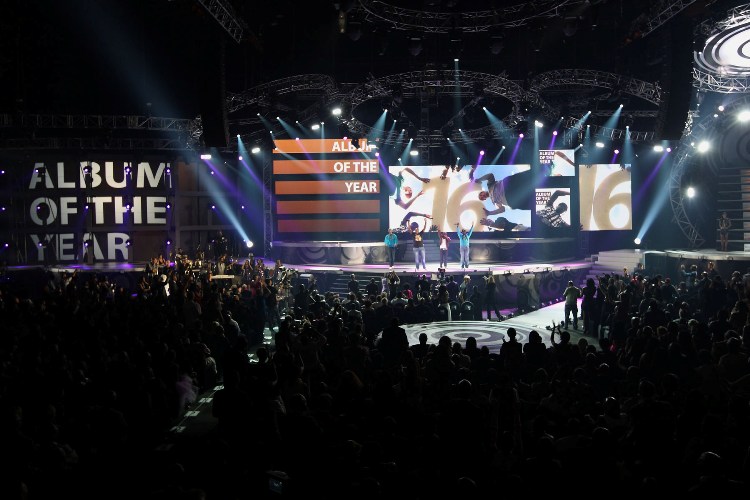 Rigging
Rigging
The first Gearhouse team onsite was, naturally, Rigging, with head rigger Kendall Dixon applying some serious energy and smart thinking into getting a production as large and as heavy as this fitted safely into the venue!
It was split between flown and ground supported components, and involved a spider’s web of intricate bridling (a veritable “wonderland” for rigging anoraks) to get each of the 120 roof points exactly where they were needed. An optimum goal was to squeeze as much height as possible out of the room, resulting in a reasonable 12.5 metres of headroom at the highest points and shrinking down to 8.5 at the lowest.
Integral to Dunn’s lighting design were 3 large, raked, circular trusses in the air above the main stage, and a fourth, complete with stretched, painted skin, above the bottom of the stairs. Another circular truss was directly above the presenter stage in the middle of the audience.
The ground support was built from TFL heavy duty trussing, and all the LED screens on the show – weighing 9.5 tonnes in total – were attached to this. The screens were also moved in and out throughout the show, via an IBEX motor controller allowing the presenters to walk through and bands and live artists to enter and exit.
The flown rig – lighting and PA – weighed 13 tonnes, the maximum roof weight loading as stipulated for this show by the Superbowl’s structural engineers.
They have rigged in the building many times before, and that intimate knowledge of the space and the whereabouts of obstructions like the AC ducts and other plant etc., all helped the operation run smoothly.
Audio
Marius Marais – also a recent Award winner – of the 2010 TPSA’s Sound Engineer of the Year – mixed FOH, while Kholofelo Sewela took care of the busy monitor world.
The L-Acoustics Kudo sound system supplied by Gearhouse Audio was spec’d for the event by Dave Tudor and Adriaan Van der Walt who have used it before in the Superbowl, and knew it had all the parameters to give an excellent result.
The main challenge included being limited for positions because of the amount of roof points taken up by the lighting rig! Working with a wide set is always interesting, and the subs were even wider on this occasion, so time alignment was complicated. They also had to try and keep the PA as concealed as possible for sightlines and camera angles. Other exacting tasks were the short rehearsal time for the live artists, and, during the show, the need for lightening quick changeovers and some seriously on-the-ball mic’ing up and line checking.
The main arrays were 2 left and right hangs of 12 Kudos per side, with 6 x dV-DOSCs a side for outfills. The main hangs were about 6 metres off the downstage edge of the stage and 11 metres from centre, so the PA was a lot narrower than the stage space.
For further infill were 2 L-Acoustics Hi-Q wedges flown on a truss, for the artists performing on and around the edges of the stage. There were another 12 of these on the floor acting both as infills and monitors. All were driven by LA8 amps. The SB118 subs were required to be out of sight, so they were right offstage, approximately 34 metres apart – a total of 16 subs in 2 stacks, and on top of these were a further 2 more dV infills.
Marais chose a Soundcraft Vi6 console to mix the show, utilising all the onboard effects and processing. He engineered all the bands, live artists and the presenters, etc. For the Awards stings and walk ups, Gearhouse Audio supplied a Yamaha LS9-32 console which was operated by Henno Ritchie, again utilising all the onboard effects.
The monitor console was the de rigueur Yamaha PM5D, and from that he also sent a feed to the OB van.
Monitors were a combination of the Hi-Qs and Sennheiser EW300 IEMs, and the Gearhouse Audio crew numbered 9 including the two engineers.
After comment
Tim Dunn said afterwards that the 2010 SAMAs was one of the “most enjoyable” shows he has worked on. The many reasons include the great teamwork and technical acumen involved in creating a spectacular end result, the diversity and quality of the live performances and the exhilaration of working on highly visible live TV shows – something of which he never tires.
“It was magic from the start – we had a great team on board, all determined to really make this the best SAMA’s ever and I believe we achieved our goal. Walking into the Superbowl on the first day after our stage was finished and the first lights went on – I just knew it was going to be spectacular. I am proud to have been on the forefront of this fantastic event – it made us all feel proudly South African” – Delmarie Seaward, Executive Producer.


